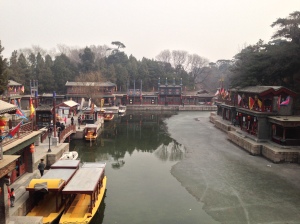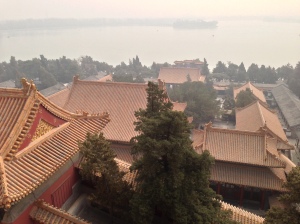Greetings from the future!
Oh what marvelous adventures we have had in Beijing, our first stop in this future world where our today is your tomorrow. The sights, sounds, smells and tastes, once foreign to us, are becoming more familiar but our journey has only just begun and many destinations still await our arrival.
If only we had the time, and you the interest, for individual blog posts on each fantastical vision we encounter on our travels, but we must keep moving forward and our time in Beijing is over. We have actually moved on to our second, third and fourth destinations, but before we update you with dispatches from these newest eastern outposts, here is a look back at our adventures in Beijing.
The Summer Palace
On our third day in Beijing, we somewhat casually decided to take the subway out to the Summer Palace. The Summer Palace is perhaps most closely associated with the empress dowager Cixi, a controversial figure in Chinese history. It’s not that we didn’t think it would be a worthwhile sight to see, we just underestimated how taken we would be with its confluence of architecture and landscape design.
A UNESCO World Heritage Site, the Summer Palace boasts an abundance of pavilions, temples, shrines, halls and bridges all set amidst a natural setting of incredible beauty.
I present to you the Summer Palace:
Lama Temple and Temple of Confucius
What cathedrals are to Europe and ancient ruins to South America, so are pavilions to China. Pavilions seem to be the mainstay for every site of historical importance: the Forbidden City, the Summer Palace, and so it is the case with these two impressive religious sites of worship.
The Lama Temple is said to be the most renowned Buddhist temple outside of Tibet and is still an active site of worship. Chris and I respectfully lit three joss (incense) sticks and presented them before the Hall of Boundless Happiness, which contains the largest wood carved Buddha in the world.
The Temple of Confucius, where people worshipped Confucius during the Yuan, Ming and Qing Dynasties, was initially built in 1303, according to signage contained within the Temple. Confucius is enshrined in the main structure, Da Cheng Hall.
Photography wasn’t permitted at the Lama Temple, so these are just from the Temple of Confucius:
The 798
Many tourists are drawn to China because of its offerings of antiquity. The Great Wall, centuries old temples, shrines and artifacts dating back to pre-BCE — touring China provides a passport to the ancient world. That said, part of what makes China so compelling is the juxtaposition of the old with the new. Modernity abounds in China, especially in its urban areas. The country is seemingly on the cutting edge of most things, and the 798 Art District, made famous by artists like Ai Weiwei, is a perfect example of this contrast.
Here is a description from 798district.com:
798 stands for much more than a three digit number: in Beijing these numbers symbolize the country’s cutting edge art movement led by the Chinese vanguard, unchained artistic personalities with alternative life goals. The largest, most influential art district in China – the 798 – hosts world-class international and Chinese exhibitions in the midst of former weapons factories.
And here are our photos from the 798:
Some of the photos (Nikon camera) from the 798 were contributed by guest photographer, Leviathon Murphy.
Enjoy and we’ll talk again soon. Next stop, Qingdao!







































Maria, I’m really enjoying your stories, great work! Looks like Chris is getting iMovie figured out too!
LikeLike